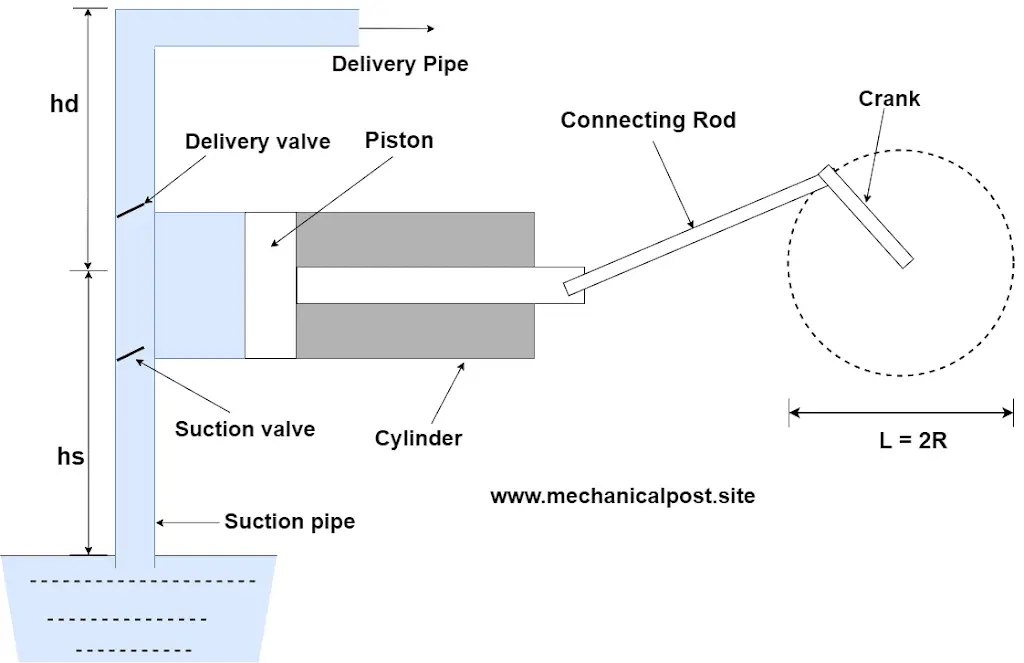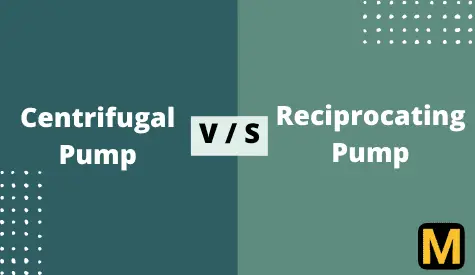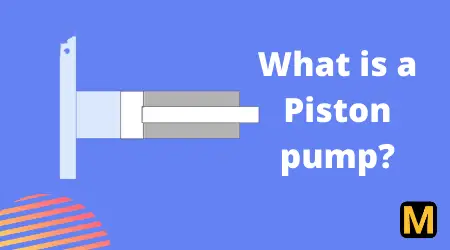Reciprocating pump – construction, working, advantages, uses with PDF
Today at The Mechanical post we’ll see about what is a reciprocating pump? its construction, working, advantages, disadvantages, applications, and formulae regarding the reciprocating pump.
Download the PDF on the Reciprocating pump at the end of the article.

Definition of Reciprocating pump
Reciprocating pump is a mechanical device which is used to deliver (or pump) the liquid with the help of a piston which reciprocates inside an enclosed cylinder.
The Reciprocating pump is also called a positive displacement pump because it actually does work on the liquid by compressing it.
Working principle
The reciprocating pump works on the principle that when a piston moves to and fro in an enclosed cylinder, it causes suction and compression of the liquid resulting in suction at the inlet and delivery at high pressure at the outlet.
Construction of reciprocating pump
The basic components of a single-acting reciprocating pump are:
Plunger / piston
Unlike centrifugal pump which has an impeller, the reciprocating pump has a piston or plunger and it reciprocates in the cylinder due to which suction and increase in pressure takes place.
Piston rod
The piston rod connects the connecting rod to the piston and transfers reciprocating motion to the piston from the connecting rod. As shown in the figure below.
Connecting rod
The connecting rod is used to connect the piston rod to the Crank.
Crank
The crank is connected to a prime mover which may be an electric motor an engine. This crank is then connected to the connecting rod as shown in the figure below. Thus the rotary motion of the crank is converted into the reciprocating motion of the piston rod.
Suction pipe
It is the pipe that connects the reservoir to the inlet cylinder of the pump as shown in the figure.
Delivery pipe
The delivery pipe is used for delivering the pressurized liquid coming out from the pump to its destination.
Suction and delivery valve
These are non-return valves and allow the liquid to enter from one direction only. One valve is fitted at the inlet of the cylinder whereas the other is fitted at the outlet of the cylinder as shown in the figure. This ensures that the water or the liquid doesn’t flow backward.
Strainer
A Strainer is attached at the beginning of the suction pipe so as to prevent the entering of any foreign material or particles.

Working of single acting reciprocating pump.
The crank of the reciprocating pump is connected to a prime mover like an electric motor or an engine. Crank and connecting rod converts rotary motion into reciprocating or to and fro motion of the piston.
Assuming the crank is rotating clockwise, the piston will move from left to right until it reaches the rightmost point. During this, suction takes place in the cylinder. This stroke is called the suction stroke.
The liquid is sucked in from the sump during this stroke as a vacuum is created within the cylinder.
The suction also causes the suction valve to open and the liquid reaches the cylinder. At this point, the piston is at the rightmost position.
Now as the crank rotates further and goes from the rightmost to the leftmost point (i.e. the lower semicircle) the return stroke takes place. In the return stroke, the liquid inside the cylinder is compressed by the piston as it moves from right to left.
The compression results in a pressure rise which opens up the discharge valve and the liquid is forced out through the delivery pipe.
Discharge of reciprocating pump
The discharge of the single-acting reciprocating pump is not continuous because during one revolution of the crank half the time is consumed by the suction stroke and only half the time discharge occurs.
This can be seen in the graph shown below

Let θ be the crank angle. Now let us assume the rightmost point of the crank circle as 0 degrees.
So this is the suction stroke and hence discharge is zero. As it completes a semicircle i.e. 180 degrees, only then the discharge starts (i.e the return stroke starts) and we can see the graph rising.
The discharge is maximum when the crank is at 270 degrees at the bottommost point of the circle and the piston is in the middle of the cylinder.
After that, the discharge continues to drop from 270 to 360 degrees and the cycle begins once again.
Slip in reciprocating pump
Slip in a reciprocating pump is defined as, ” The difference between the theoretical discharge and the actual discharge of the pump”.
The actual discharge of the pump is less than the theoretical discharge due to the small amount of leakage.
You might also want to read these:
- What is a Reciprocating air compressor?
- Leaf spring construction and working
- Best Laptops for Mechanical engineering students in India
- What is piston pump?
- Vapour compression cycle
Reciprocating pump discharge formula
A single-acting reciprocating pump has one suction stroke and one delivery stroke for one rotation of the crank. The liquid is delivered by the pump during delivery stroke only.
Let,
R = Radius of crank
L = Length of stroke = 2R A = Cross-sectional area of the cylinder
N = speed of pump in r.p.m = N/60 r.p.s
Then,
Stroke volume = A × L
Discharge of pump per second (Q ) = stroke volume × no of revolutions/sec
Q = A × L × N / 60
Work done by Reciprocating pump formula
Weight of water discharged per sec W= w × Q
Where, w = specific weight of the liquid. Q = Discharge of pump / sec
Work done by the pump = Weight of water discharged/sec × Total height through which the water is lifted.
Work done by pump = W × ( Hs + Hd)
Advantages of reciprocating pump
- The reciprocating pump requires no priming.
- It can be used to deliver liquid at higher pressure.
- It has higher efficiency as compared to a centrifugal pump.
- Starting torque is less.
- It can work in a wide pressure range.
Disadvantages of reciprocating pump
- The reciprocating pump has a high maintenance cost due to more wear and tear of the parts.
- As compared to centrifugal pumps, it is heavy and bigger in size.
- The initial cost is high.
- The flow rate of the liquid delivered is low.
- Requires more floor area and heavy foundation.
Applications of reciprocating pump
- Reciprocating pumps are used as a feed pumps for boilers.
- For pumping industrial fluids.
- Oil drilling operations.
- Hydraulic jack.
- Fire fighting application.
- Fuel injection in automobile engines.
╍╍╍╍╍╍╍╍╍╍
So that is a brief on the Reciprocating pump. If you like this post or have any suggestions do let us know in the comments we would love to hear from you.
Also, share this post with fellow engineers with the social links provided below.





